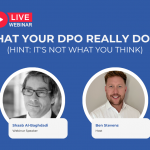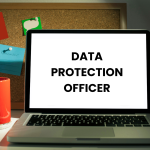White Paper on Privacy, Education and Training
Author: Shaab Al-Baghdadi
CIPPE, CIPM, CIPT, CDPO, CLPI, Certified F.Inst.D
Introduction
Education and training have not changed fundamentally for many years.
Although we have seen new approaches and theories in the way in which training is delivered, we have not necessarily considered the environment in which learners operate.
The traditional classroom may have changed in location, layout, look and feel but when learners enter that environment, the expectation is known. Social norms are established and both, the educator and learner, are mentally prepared for what is to come over an expected period. Technology has also entered the learning environment from a blackboard and chalk to whiteboards and the introduction of external video and learning content.
However recently, technology has become, not just an enhancement to learning; but more the access to learning.
This poses a few considerations
- How does the new interaction of technology, the learner and the educator change?
- How do we get close to the same learning experience or something new?
- What does this mean for individuals’ privacy?
Technology and our relationship with it
As an enabler, to enhance the learning experience, both learner and educator are well versed and comfortable with the use of technology, indeed very little is required in the explanation of how these are used by both parties.
However, the way in which we now consume technology has changed, it supplies us with communication, entertainment, work capabilities, news, commerce and social networking etc.
Recently we have seen a shift where technology will also be the gateway to education rather than an enabler to education. The privacy concerns around the invasion of an individual’s private and work life regarding the aforementioned use, have long been debated, but this different use as a source in the mainstream of training and education is new, as is the individual’s association with this new environmental relationship.
When using technology for our everyday needs, we expect flexibility and agility more and more. We are switching from one use to another at the same time and of course not in the traditional environment.
Think of a traditional work model: 09:00 go to work, 12:00 lunch and a catch up with colleagues, 17:30 finished and onwards to home, 18:30 meal, paper, television.
Each of those steps represents a specific function, (work, news, home life etc) and more importantly in an associated environment, setting the expectation for that specific step or task. Now we are combining all these tasks from multiple locations “the mobile workforce or citizen.”
This means that a specific step or task will perhaps not get the traditional level of focus time. That is not to say it will not be completed, but more that it is not a linear process, we switch and we can do this in various environments, work, home, leisure etc. Our attention to each step is interrupted and we have adapted to this new paradigm of thinking.
The norms of consumption and environments have changed; but how has training and education adjusted? The situation will not change, it has been accelerated by the recent global pandemic and environmental concerns and business cost savings are also influential factors in this.
The unique challenge for training and education are that they have not traditionally, had to deal with delivery in desperate environments and through technology as a core method.
If you are reading this on a laptop, mobile device, or workstation, how many other applications do you have open? How many other devices do you have that can also connect to you and what are they delivering; news, work, social etc? The question then becomes, how much attention time I have with you, before I must compete with another source, in your home, work or even on your journey home.
Learning does not normally have these levels of distractions or environmental situations; they are not the norm for the learning experience.
Evolution or Revolution
The issue is not around the capability of the educator, their subject knowledge or experience; but more with how they can adapt to this new situation and strategize to meet this new classroom environment.
We also need to consider the fact that the learner will have, the same expectation of interaction with the technology, as they have with other forms of consumption. The educator will need to adapt the timing, content and engagement strategies.
However, before we consider these situations, we need to ask; do we want to emulate what has gone before? Insofar as getting as close to the traditional classroom; or reinventing the learning experience from scratch.
The options of emulation (traditional), from scratch (New Frontier or a combination of both (Hybrid), depends on, amongst other variables, your audience timings, material and of course – class size. This should be your starting point, allowing you to develop and implement the correct strategies; to obtain maximum engagement and lead to the richest learning experience possible.
The considerations and starting points for these 3 approaches, are outside of the scope of this paper but will set the foundation, for the necessary amount of flexibility that needs to be designed into the course.
Is it safe?
Each of these approaches, Traditional, New frontier or Hybrid, of course, have privacy concerns, both for the learner and the educator. Let us first take a quick look at an overview of some common privacy invasions that can occur:
Surveillance
Interrogation
Aggregation
Identification
Insecurity
Secondary use
Exclusion
Breach of Confidentiality
Disclosure
Distortion
Exposure
Increased Accessibility
Blackmail
Appropriation
Intrusion
Decisional Interference
The above is of course, not the only way to understand what types of invasion can be manifested either through intent or consequentially, but as a starting point we can see that when inviting the learner and educator into new and personal environments
How these privacy harms are mitigated, will come from both the technology providers and the individuals involved.
As an example, we instinctively feel that by seeing the faces of who we are dealing with, enhances and creates better engagement because we are in a better position to read the subtle cues from an individual’s expression.
This may be the case when dealing in a real environment, but what happens when we enter the virtual world and are viewing individuals through the “single pane” of a monitor?
As such, is this of real value when measured against the potential privacy harms that may occur as listed above?
Each case and situation are different, and it is down to the parties involved to make an assessment, specifically, the Data Protection Assessment.
Summary
In order to remain relevant and deliver the best level of education possible, we need to understand and adapt to this new paradigm of thinking, when delivering education and training in the environments we are now working in.
Furthermore, how we can achieve this, whilst protecting the privacy of all participants.
At OnlineDPO we have considered how to meet the requirements to include flexibility for learners and now offer multiple delivery styles for our virtual training.
Working with our professional partners at IAPP, OnlineDPO can offer learners the opportunity to work around their individual priorities and needs by providing a multitude of learning options as can be seen on our website.
This paper was sponsored by GDPR.ie






